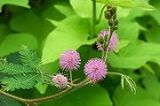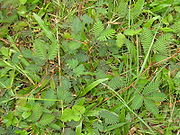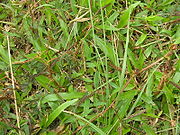
Mimosa
Encyclopedia
Mimosa is a genus
of about 400 species of herbs and shrubs, in the subfamily Mimosoideae
of the legume family Fabaceae
. The generic name is derived from the Greek
word μιμος (mimos), meaning "mimic."
There are two species in the genus that are notable. One is Mimosa pudica
, because of the way it folds its leaves when touched or exposed to heat. It is native to southern Central
and South America
but is widely cultivated elsewhere for its curiosity value, both as a houseplant
in temperate areas, and outdoors in the tropics. Outdoor cultivation has led to weed
y invasion
in some areas, notably Hawaii
. The other is Mimosa tenuiflora, which is best known for its use in shamanic ayahuasca
brews due to the psychedelic drug DMT
found in its root bark.
(Silk Tree) and Acacia dealbata
(Sattle).
; examples outside of Mimosa include the Telegraph Plant, and the Venus Flytrap
. The leaves of the plant close quickly when touched. Some mimosas raise their leaves in day and lower them at night, and experiments done by Jacques d'Ortous de Mairan on mimosas in 1729 provided the first evidence of biological clocks. Mimosa can be distinguished from the large related genera, Acacia
and Albizia
, since its flowers have 10 or fewer stamen
s. Note that, botanically, what appears to be a single globular flower is actually a cluster of many individual ones. Mimosa contains some level of heptanoic acid
.
_in_hyderabad,_ap_w_img_9141.jpg)

 There are about 400 species including:
There are about 400 species including:
Genus
In biology, a genus is a low-level taxonomic rank used in the biological classification of living and fossil organisms, which is an example of definition by genus and differentia...
of about 400 species of herbs and shrubs, in the subfamily Mimosoideae
Mimosoideae
Mimosoideae is a subfamily of the flowering plant family Fabaceae characterized by flowers with small petals and numerous prominent stamens...
of the legume family Fabaceae
Fabaceae
The Fabaceae or Leguminosae, commonly known as the legume, pea, or bean family, is a large and economically important family of flowering plants. The group is the third largest land plant family, behind only the Orchidaceae and Asteraceae, with 730 genera and over 19,400 species...
. The generic name is derived from the Greek
Greek language
Greek is an independent branch of the Indo-European family of languages. Native to the southern Balkans, it has the longest documented history of any Indo-European language, spanning 34 centuries of written records. Its writing system has been the Greek alphabet for the majority of its history;...
word μιμος (mimos), meaning "mimic."
There are two species in the genus that are notable. One is Mimosa pudica
Mimosa pudica
Mimosa pudica , is a creeping annual or perennial herb often grown for its curiosity value: the compound leaves fold inward and droop when touched or shaken, re-opening minutes later...
, because of the way it folds its leaves when touched or exposed to heat. It is native to southern Central
Central America
Central America is the central geographic region of the Americas. It is the southernmost, isthmian portion of the North American continent, which connects with South America on the southeast. When considered part of the unified continental model, it is considered a subcontinent...
and South America
South America
South America is a continent situated in the Western Hemisphere, mostly in the Southern Hemisphere, with a relatively small portion in the Northern Hemisphere. The continent is also considered a subcontinent of the Americas. It is bordered on the west by the Pacific Ocean and on the north and east...
but is widely cultivated elsewhere for its curiosity value, both as a houseplant
Houseplant
A houseplant is a plant that is grown indoors in places such as residences and offices. Houseplants are commonly grown for decorative purposes, positive psychological effects, or health reasons such as indoor air purification...
in temperate areas, and outdoors in the tropics. Outdoor cultivation has led to weed
Weed
A weed in a general sense is a plant that is considered by the user of the term to be a nuisance, and normally applied to unwanted plants in human-controlled settings, especially farm fields and gardens, but also lawns, parks, woods, and other areas. More specifically, the term is often used to...
y invasion
Invasive species
"Invasive species", or invasive exotics, is a nomenclature term and categorization phrase used for flora and fauna, and for specific restoration-preservation processes in native habitats, with several definitions....
in some areas, notably Hawaii
Hawaii
Hawaii is the newest of the 50 U.S. states , and is the only U.S. state made up entirely of islands. It is the northernmost island group in Polynesia, occupying most of an archipelago in the central Pacific Ocean, southwest of the continental United States, southeast of Japan, and northeast of...
. The other is Mimosa tenuiflora, which is best known for its use in shamanic ayahuasca
Ayahuasca
Ayahuasca is any of various psychoactive infusions or decoctions prepared from the Banisteriopsis spp. vine, usually mixed with the leaves of dimethyltryptamine-containing species of shrubs from the Psychotria genus...
brews due to the psychedelic drug DMT
Dimethyltryptamine
N,N-Dimethyltryptamine is a naturally occurring psychedelic compound of the tryptamine family. DMT is found in several plants, and also in trace amounts in humans and other mammals, where it is originally derived from the essential amino acid tryptophan, and ultimately produced by the enzyme INMT...
found in its root bark.
Taxonomy
The genus Mimosa has had a tortuous history, having gone through periods of splitting and lumping, ultimately accumulating over 3,000 names, many of which have either been synonymized under other species or transferred to other genera. In part due to these changing circumscriptions, the name "Mimosa" has also been applied to several other related species with similar pinnate or bipinnate leaves but now classified in other genera, most commonly to Albizia julibrissinAlbizia julibrissin
Albizia julibrissin is a species of legume in the genus Albizia, native to southwestern and eastern Asia, from Persia east to China and Korea...
(Silk Tree) and Acacia dealbata
Acacia
Acacia is a genus of shrubs and trees belonging to the subfamily Mimosoideae of the family Fabaceae, first described in Africa by the Swedish botanist Carl Linnaeus in 1773. Many non-Australian species tend to be thorny, whereas the majority of Australian acacias are not...
(Sattle).
Description
Members of this genus are among the few plants capable of rapid movementRapid plant movement
Rapid plant movement encompasses movement in plant structures occurring over a very short period of time, usually under one second. For example, the Venus Flytrap closes its trap in about 100 milliseconds. The Dogwood Bunchberry's flower opens its petals and fires pollen in less than 0.5 milliseconds...
; examples outside of Mimosa include the Telegraph Plant, and the Venus Flytrap
Venus Flytrap
The Venus Flytrap , Dionaea muscipula, is a carnivorous plant that catches and digests animal prey—mostly insects and arachnids. Its trapping structure is formed by the terminal portion of each of the plant's leaves and is triggered by tiny hairs on their inner surfaces...
. The leaves of the plant close quickly when touched. Some mimosas raise their leaves in day and lower them at night, and experiments done by Jacques d'Ortous de Mairan on mimosas in 1729 provided the first evidence of biological clocks. Mimosa can be distinguished from the large related genera, Acacia
Acacia
Acacia is a genus of shrubs and trees belonging to the subfamily Mimosoideae of the family Fabaceae, first described in Africa by the Swedish botanist Carl Linnaeus in 1773. Many non-Australian species tend to be thorny, whereas the majority of Australian acacias are not...
and Albizia
Albizia
Albizia is a genus of about 150 species of mostly fast-growing subtropical and tropical trees and shrubs in the subfamily Mimosoideae of the legume family, Fabaceae. The genus is pantropical, occurring in Asia, Africa, Madagascar, Central, South, and southern North America and Australia, but mostly...
, since its flowers have 10 or fewer stamen
Stamen
The stamen is the pollen producing reproductive organ of a flower...
s. Note that, botanically, what appears to be a single globular flower is actually a cluster of many individual ones. Mimosa contains some level of heptanoic acid
Heptanoic acid
Heptanoic acid, also called enanthic acid, is an organic compound composed of a seven-carbon chain terminating in a carboxylic acid. It is an oily liquid with an unpleasant, rancid odor. It contributes to the odor of some rancid oils...
.
Species
_in_hyderabad,_ap_w_img_9141.jpg)


- Mimosa aculeaticarpa Ortega
- Mimosa aculeaticarpa var. biunciferaMimosa aculeaticarpa var. biunciferaMimosa aculeaticarpa var. biuncifera is a shrub in the Fabaceae family. It is commonly known as the catclaw mimosa or the wait-a-minute bush and is endemic to upland regions of Mexico, Arizona, New Mexico and Texas...
Ortega
- Mimosa aculeaticarpa var. biuncifera
- Mimosa arenosa (Willd.) Poir.
- Mimosa asperata L.
- Mimosa borealis Gray
- Mimosa casta L.
- Mimosa ceratonia L.
- Mimosa diplotrichaMimosa diplotrichaMimosa diplotricha, also known as the giant sensitive plant, is a species in the Fabaceae family.A native from Brazil, it is extremely invasive in the Pacific, where it has been introduced on all island groups, except Tonga...
C.Wright ex Sauvalle - Mimosa dysocarpa Benth.
- Mimosa dysocarpa var. dysocarpa Benth.
- Mimosa emoryana Benth.
- Mimosa grahamii Gray
- Mimosa grahamii var. grahamii Gray
- Mimosa hostilisMimosa hostilisMimosa tenuiflora is a perennial evergreen tree or shrub native to the northeastern region of Brazil and found as far north as southern Mexico...
- Mimosa hystricina (Small ex Britt. et Rose) B.L.Turner
- Mimosa latidens (Small) B.L. Turner
- Mimosa laxiflora Benth.
- Mimosa malacophylla Gray
- Mimosa microphylla Dry.
- Mimosa nuttalliiMimosa nuttalliiMimosa nuttallii, the Catclaw Brier or Sensitive Brier, is a herbaceous perennial legume in the subfamily Mimosoideae. It has a trailing semiwoody vine covered with small recurved prickles that can be painful to bare skin....
(DC.) B.L. Turner - Mimosa pellita Kunth ex Willd.
- Mimosa pigraMimosa pigraMimosa pigra , is an invasive species of the genus Mimosa, in the family Fabaceae. It is native to the Neotropics, but has been listed as one of the world's 100 worst invasive species, and has been documented in: Australia, Cambodia, Dominican Republic, Ghana, Guinea, Indonesia, Kenya, Malaysia,...
L.- Mimosa pigra var. pigra L.
- Mimosa pudicaMimosa pudicaMimosa pudica , is a creeping annual or perennial herb often grown for its curiosity value: the compound leaves fold inward and droop when touched or shaken, re-opening minutes later...
L. - La sensitive - Mimosa quadrivalvis L.
- Mimosa quadrivalvis var. hystricina (Small) Barneby
- Mimosa roemeriana Scheele
- Mimosa rubicaulisMimosa rubicaulisMimosa rubicaulis is a shrub belonging to Fabaceae and subfamily Mimosoideae. It is bipinnately compound, each leaf having 8-12 pairs of pinnae, each with 16-20 pairs of pinnules, unlike Mimosa pudica which has at most two prickly pairs of leaflets. It is found across India.It is a large straggling...
Lam. - Mimosa rupertiana B.L. Turner
- Mimosa scabrellaMimosa scabrellaMimosa scabrella is a tree in the Fabaceae family. It is very fast growing and it can reach a height of 15 m tall in only 3 years. Its trunk is about 0.1-0.5 m in diameter. It has yellow flowers. The tree's seeds number about 65,000–70,000 seeds/kg.-Uses:Before the advent of the diesel...
Benth. - Mimosa schomburgkii Benth.
- Mimosa somniansMimosa somniansMimosa somnians is a tree in the Fabaceae family. It is native to the Caribbean, Central America and South America. It is a short, low lying shrub with minuscule thorns lining its stems like hairs. Its leaves are sensitive, meaning that, when touched, they close quickly, similarly to Mimosa pudica...
- Mimosa strigillosaMimosa strigillosaMimosa strigillosa, also known as Sunshine Mimosa, and Powderpuff is a perennial ground cover in the Fabaceae family that is native to nearly all US states bordering the gulf of Mexico and grows north into Georgia and Arkansas as well. The name Powderpuff refers to the small spherical flowers that...
Torr. et Gray - Mimosa tenuiflora (Willd.) Poir. (= Mimosa hostilis)
- Mimosa texanaMimosa texanaMimosa texana is a shrub in the Fabaceae family. It is commonly known as the Texas mimosa, the Texas catclaw or the Wherry mimosa and is endemic to upland regions of Mexico and Texas. This species used to be classified as Mimosa biuncifera but it was found that phenotypic variations occurred across...
(Gray) Small - Mimosa turneri Barneby
- Mimosa verrucosaMimosa verrucosaMimosa verrucosa, Jurema Branca or Jurema De Oieras is a species of legume in the Fabaceae family.It is a shrub or small tree native to Brazil...
Benth.George BenthamGeorge Bentham CMG FRS was an English botanist, characterized by Duane Isely as "the premier systematic botanist of the nineteenth century".- Formative years :...

